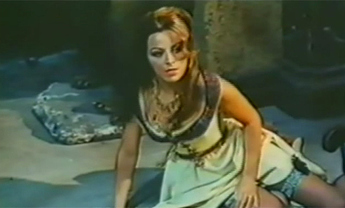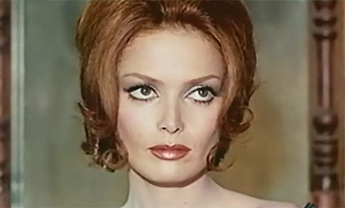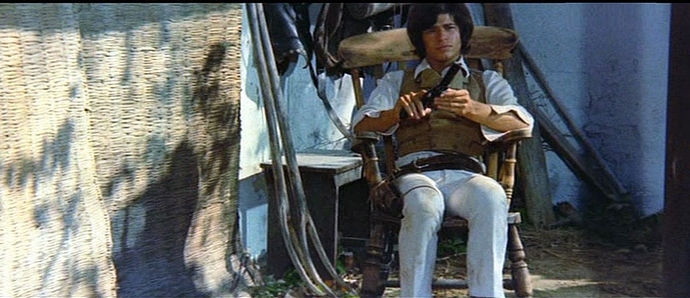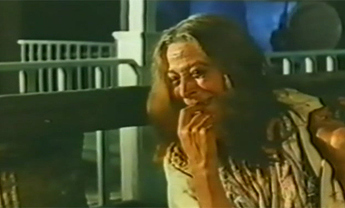![]() Yes, der liebe Märchenonkel Thomas … an infinite source of jocularity. His synopsis of La taglia è tua … surely is beyond the pale. I simply couldn’t resist the temptation to translate it into German.
Yes, der liebe Märchenonkel Thomas … an infinite source of jocularity. His synopsis of La taglia è tua … surely is beyond the pale. I simply couldn’t resist the temptation to translate it into German.
The remarkable story of El Puro’s origin:
According to [Fabrizio] Gianni, not only did he discover a young Klaus Kinski for A Few Dollars More [sic] in 1965, he also originated Clint Eastwood’s poncho-wearing, cigar-chomping gunman hero. “I used to write scripts and created the character of El Puro for Sergio Leone when he was making A Fistful of Dollars in 1964,” he says. “It was a collaboration with [director/actor] Fernando Lamas and it was a play on the Spanish word puro, which means ‘cigar’ and also ‘the pure one’. Sergio paid me 50 for El Puro – I never dreamed he would become one of the most recognisable film characters in the world.”
Reminds me of the ending of Jesus Christ Superstar, personally I prefer the finale as it is.
Considering the ‘Buddhist SW’ thing, bare feet could be intended as symbol of disembodied soul.
[quote=“Companero_M, post:296, topic:795”]
Does the Italian version’s dialogue mention the name Joe Bishop?[/quote]
Yes, when the wanted poster appears for the first time.
The uncredited Lisa Seagram (the bar owner) and Mariangela Giordano are called Babe and Sugar respectively, Rosalba Neri is Rosie.
I answer my own question: in RaiMovie version the differences are English credits on a black blackground (instead of sky blue), the voice over also present in the French and Portuguese dubs and a welcome medium close-up at the very end of the movie.
As for the original title, another (very interesting) possibility is that Specs and Fernando - described as a rather ambiguous character - made an agreement.
Fernando: “After so many years you should know that I’m on the side always of the winner. There will be only three of them, Specs just probably won’t be here”. How does he know? Also, Gypsy Cassidy and Tim… who revealed their weaknesses to Fernando? (see voice over sequence, missing from the English dub)
Thank you, JonathanCorbett! In this scene, right?
English dialogue:
GYPSY: Allez, professor!
SPECS: I’m comin’, boyo! [reads] Reward … dead or alive … El Puro … ten thousand dollars. – Ten thousand dollars!
DOLPH: Hey!
TIM and DOLPH: Haw, haw!
SPECS: That’s a goodly sum. It’s an awful lotta money.
GYPSY: Chicken feed! Once El Puro’s gone, all the chickens are ours. Right … Specs?
SPECS: Right … Gypsy.
Rosie (Neri) calls her “Sugar.” This is Mariangela Giordano:
Tim (Brega) calls her “Babe.” This is Lisa Seagram:
I’m sorry, but I don’t get it. Which voice-over are you referring to? And what do you mean by “welcome medium close-up”?
Fernando’s just guessing. He thinks that Specs “won’t be here” because “he values his life.” Why would Fernando betray El Puro? He needs him as a (dirty business) partner.
I think the Italian title relates to Gypsy’s lethal obsession with El Puro. I can easily imagine Gypsy telling his gang members: “The reward’s yours, but the man’s mine!”
Again, which voice-over sequence are you referring to? I don’t remember such a scene or sequence being in the French version I watched. Maybe bad memory.
By the way, what’s your opinion about Fabrizio Gianni’s claim that he created (or “originated”) the Joe/Monco/Blondie character for Sergio Leone (as quoted above)? If it’s true, it would contradict everything Leone and Clint Eastwood said about the genesis of the so-called “man with no name” – an intriguing thought.
After the hit character (I try to avoid spoilers) falls from his horse in the RaiMovie version there is an additional, closer shot which in my view makes the scene better
It is the scene immediately after those words by Fernando: only music in the English dub, voice over in the Italian, French and Portuguese dubs, confirming they will be three and explaining how to prevail against them thanks to their weaknesses.
.[quote=“Companero_M, post:307, topic:795”]
Why would Fernando betray El Puro? He needs him as a (dirty business) partner.
[/quote]
For the reward money, of course. [quote=“Companero_M, post:307, topic:795”]
I think the Italian title relates to Gypsy’s lethal obsession with El Puro. I can easily imagine Gypsy telling his gang members: “The reward’s yours, but the man’s mine!”
[/quote]
But those involved are two, otherwise it should be La taglia è vostra, l’uomo lo ammazzo io.
Thanks, now I get it. The word “welcome” confused me.
Yes, you’re right. I watched the French version more than two years ago. Memory failed me. And I thought you meant a voice-over by a non-diegetic narrator. In our case, it’s a character in the story, Fernando, who tells El Puro about the villains’ shortcomings, while we see them approaching town. The dialogue of one scene is carried over into the next scene. As this formal/stylistic device is used only once in the entire film, I guess I wouldn’t call it a voice-over. Fernando’s not the movie’s narrator. But that’s a moot point, I know what you mean.
Okay, let’s assume Fernando and Specs are secret partners. So they stage the final shoot-out, convinced that with Fernando’s help El Puro will be triumphant. Dolph’s already dead, and after the gunfight Cassidy, Tim and Gypsy are out of the way. Specs shoots El Puro. And then? He rides away, happily knowing that he made Fernando a rich man? Because that must have been their agreement: Specs gets to kill El Puro, Fernando takes the money – “la taglia è tua, dear Fernando, but l’uomo l’ammazzo io, Specs, killer and philanthropist.” I don’t know … most unlikely.
What would Specs get out of the deal? He’s not obsessive about El Puro. He’s the most rational of the bunch. So if we assume that Fernando and Specs conspired against El Puro and Gypsy, we also have to assume that they did it for the reward money, which they would share after having successfully carried out their charade. And now we’re back at …
Good point.
The Italian title simply doesn’t make any sense. I don’t think it is worth the effort to search for one.
There are more films for which nobody knows what the title is supposed to mean.
El puro is the better title anyway.
I’m afraid we have to accept this as an undeniable fact. But El Puro’s alliterative original title sounds good. At least to my non-Italian ears.
Logically, one cannot say this until the withdrawn from circulation complete Italian version** will resurface.
In any case there seems to be some ambiguity in Fernando, you’ll see when you rewatch the movie.
** Speaking of which, who is this character that appears briefly at 47:40 after El Puro collapses?
Puro as a younger man obviously.
A kind of flashback to give a visual information to his rocking chair legend status.
Now that we – or rather you – had to find out that at the 64th Mostra internazionale d’arte cinematografica di Venezia in 2007 a heavily truncated, digital version was projected, we shouldn’t get our hopes up too high.
Definitely. In order to locate the sequences we discussed above I rushed through the film yesterday.
One of the most intriguing scenes in the movie and a great juxtaposition. After showing us El Puro at gun practice, dressed in black rags, deliriously trying to focus on his targets, so wasted he could stand on the banks of the Rio Grande and miss Mexico (to use a phrase by Pete Dexter), Mulargia cuts to a white-clad young man, sitting in the yard of a hacienda, confidently shooting cups off the surrounding walls and roofs. He is El Puro’s antipode: sober, focused, clean, dressed in white, young – an epiphany for the downcast, dipsomaniac gunfighter. And the beginning of his catharsis. Which will end a little later in the movie when we see El Puro sleeping peacefully in the grass, wearing a snow-white union suit, his ragged black clothes draped on bushes like a snake’s shed skin. Phoenix will rise again. (Of course, this process of purification or circle of renewal could also be described in Buddhist terms, but since my knowledge of Buddhism is rudimentary at best I gladly leave that task to someone else.)
The film doesn’t give us more information about the young man, he won’t appear again. So we’re free to speculate: he could be a younger El Puro, a younger Gypsy – or a major cutting-room error.
?
It’s definitely the young Puro. Why should it be anyone else?
If so why not Woods, being a matter of seconds? Was the age factor essential to show us El Puro at his best?
Also, in those few seconds the rocking chair could easily pass by unnoticed, while in contrast it might have a different value in the narrative. And as you well know when a movie is significantly shortened some characters are removed (Cowards Don’t Pray, A Bullet for Sandoval, Sartana in the Valley of Death and Questi’s giallo Death Laid an Egg are just a few examples).
It’s an ambiguous scene. I think it should be perceived as a synapsis between El Puro and Gypsy, establishing a doppelgänger motif. The white-clad young man in the rocking chair could be either one. The short scene in which he appears links the preceding sequence – E. P. at target practice, his delirium – with the subsequent scene: Rosie enters her room, mistaking Gypsy for El Puro. Gypsy wears a white shirt and sits in a rocking chair.
The rocking chair then provides a visual link between the two antagonists; it will appear again later: E. P. – “the rocking chair legend” – sits in it during their final confrontation. The white shirt worn by the young man links him to Gypsy, who wears one in the scene that follows, and provides a sharp contrast to El Puro, who is dressed in black in the preceding scene. The young man’s physical appearance is ambiguous, too. He resembles neither El Puro nor Gypsy – or both.
Still, I never had the slightest doubt that it is Puro.
We’re used to weird, slightly deranged or demented old men in Spaghetti Westerns – Leone had a special fondness for those characters – but old women are rare. Being the (hyper-)masculine subgenre that it is, its audiences of course preferred to watch young, beautiful women on screen. Directors and producers eagerly complied – and who would blame them? By showing us an old, deranged female drunkard (in an admittedly brief appearance), La taglia è tua … underscores its status as an exceptional western all’italiana. Right after Puro gets thrown out of the saloon by its barkeeper-bouncer (Angelo Dessy), an old woman turns around the corner and walks up to our hapless hero.
No less exceptional than the old woman’s appearance is Puro’s reaction to her. She addresses him with: “Welcome back to earth! You look pretty awful.” Yet instead of telling her to get lost or mind her own business, he tenderly caresses her right cheek.
Is Puro’s gesture merely an expression of the ‘natural’ bond between two alcoholics? He turns, bends over the hitching rail and throws up. Rosie (Neri) steps out of the saloon, telling the ghastly granny, “Go away, you witch!”
I think we’re supposed to perceive the cackling old woman as a harbinger of doom, if not Death herself (in Romance languages Death’s grammatical gender is female, e.g. la morte [Italian], la mort [French], la muerte [Spanish]). Soon Rosie and Puro will be killed. Tellingly, Puro welcomes the old woman with a gentle gesture, thereby metaphorically embracing death.
@JonathanCorbett, do you know who played her?
No idea, I think it’ll be extremely difficult - if not impossible - to identify her. She also appears shortly before El Puro discovers the lifeless body of Rosie.
In the Italian dub she says only “Welcome to hell!”





